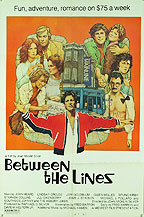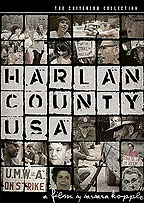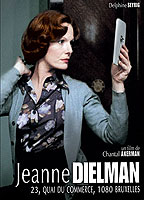Top Five 1970s Films Directed by Women
Published on December 5th, 2011 in: Dancing Ourselves Into The Tomb, Documentaries, Feminism, Issues, Listicles, Movies, Staff Picks, Top Five Lists |
3. Between the Lines (1977; directed by Joan Micklin Silver)
By the mid-1970s, director Joan Micklin Silver had taken on several roles behind the scenes. She transitioned from journalism to screenwriting when taking a job writing voiceovers for Encyclopedia Brittanica’s educational film division. This led to a position as a screenwriter for Limbo, a film that looked at the experiences of women whose husbands were prisoners of war. After she was removed from its production (due to conflicts with the director), however, Silver decided to write as well as direct.
Her first feature, Hester Street, depicted the experiences of an Orthodox Jewish émigré living in New York at the turn of the century. The film is barely remembered today, but at the time it was one of the most profitable independent features and its star, Carol Kane, earned an Oscar nomination for her performance. After working on a few educational shorts and a made-for-TV adaptation of F. Scott Fitzgerald’s “Bernice Bobs Her Hair,” Silver returned to the big screen with Between the Lines.
Working from a script pitched to her by former Real Paper writer Fred Barron, Silver’s feature follows the haphazard Robert Altman “format” that inspired so many 1970s cineastes. Between the Lines looks at the misadventures of the staff of the Back Bay Mainline, a countercultural weekly newspaper that has not transitioned well into the post-Vietnam era. Amidst the romantic dramas and artistic rejection faced by staff members, news breaks that the Mainline‘s ownership is looking to sell the paper. Though the staff is portrayed as complacent in the film’s first act, the potential sale finds them contemplating whether to desert this thing they created, or to stay and fight.
Micklin Silver’s feature doesn’t quite pull off its post-Nashville aesthetic. Unlike the cross-talking ensemble of Altman’s feature, her characters wait for the others to stop speaking before responding to them. However, actors inhabit their roles credibly, to the point where I forgot I was watching a narrative film. As a longtime Bostonian, I loved the location shooting throughout Harvard Square and the South End, both of which looked a lot more run-down and colorful than they do now.
MGM released Between the Lines as part of their Burn-On-Demand series, which is as good as the film is going to look until a Criterion-like outfit gets to restore it. Joan Micklin Silver’s work looks au courant in this post-mumblecore era, and the time seems right for a renewed look at her unassuming, engaging oeuvre.

4. Harlan County U.S.A. (1975; directed by Barbara Kopple)
Documentarian Barbara Kopple started her career auspiciously as an assistant to Albert and David Mayles, the directors behind Grey Gardens. Her training with them served her well, and she worked uncredited as a director on the legendary Vietnam documentary Winter Soldier. For her first solo directorial effort, Kopple initially intended to make a film about the attempt to unseat controversial miners’ union leader Tony Boyle from his position with the United Mine Workers of America. However, her film gained a greater scope when she chose to focus on the miners of Brookside Mines, who voted to unionize and strike against Duke Power Company.
This might sound like the kind of film you’d watch in your history class, but Kopple makes a far more engrossing film than one might imagine. In spite of her one-man band approach to filmmaking, she manages to capture some evocative shots within the mines (such as the shot of miners descending into the mine with only the lights on their hard-hats to guide them). Kopple also looks at the community surrounding the miners, most notably the wives and the folksingers (the haunting “which side are you on?” ballad appears on the soundtrack).
Harlan County U.S.A. became legendary on its release. Kopple was the first woman to win the Best Documentary Oscar, and the film was later included included in the Library of Congress’s National Film Registry. At the time it was made, however, it had a very concrete effect on the miners’ strike. Striking Eastover miner Jerry Johnson said of the production crew, “The cameras probably saved a bunch of shooting. I don’t think we’d have won it without the film crew. If the film crew hadn’t been sympathetic to our cause, we would’ve lost. Thank God for them; thank God they’re on our side.”

5. Jeanne Dielman, 23 Quai du Commerce, 1080 Bruxelles (1975; directed by Chantal Akerman)
In comparison with America, the European film industries employed many more female directors in the 1970s. Three directors made their marks as name-above-the-titles auteurs during this era: Agnes Varda, who was renowned as “the grandmother of the French New Wave”; Lina Wertmuller, the first female nominee for the Best Director Oscar; and Chantal Akerman.
Akerman’s films were more experimental in narrative approach, and less widely distributed than those of her peers. Jeanne Dielman was an especially legendary film for its running time and content. The film is a slowly-paced, clinical depiction of a lonely widow and single mother (played by Delphine Seyrig) who leads a ritualized life. Every day she sends her son off to school, prepares the evening’s dinner, cleans her house, and fields an appointment from one of her johns. The long takes of Dielman scrubbing out a bathtub or setting the table or peeling potatoes are in and of themselves strangely hypnotic, and take on a strange poignancy in light of a shocking act of violence that ends the film.
Akerman pays great attention to “women’s work,” but one of the most interesting aspects of the film is the makeup of the crew. At the time, Akerman wanted an all-female crew for this production. The crew split comes down to about a 60/40 split, with women taking on nontraditional roles such as cinematographer and sound design.
Pages: 1 2
One Response to “Top Five 1970s Films Directed by Women”
March 7th, 2012 at 4:48 pm
Nice job on these (almost lost) classics. I was only familiar with 2 of the films (Harlan County and the Elaine May film) but Chelsea piqued my interest in the others as well. Good work!
Ken
Time limit is exhausted. Please reload the CAPTCHA.